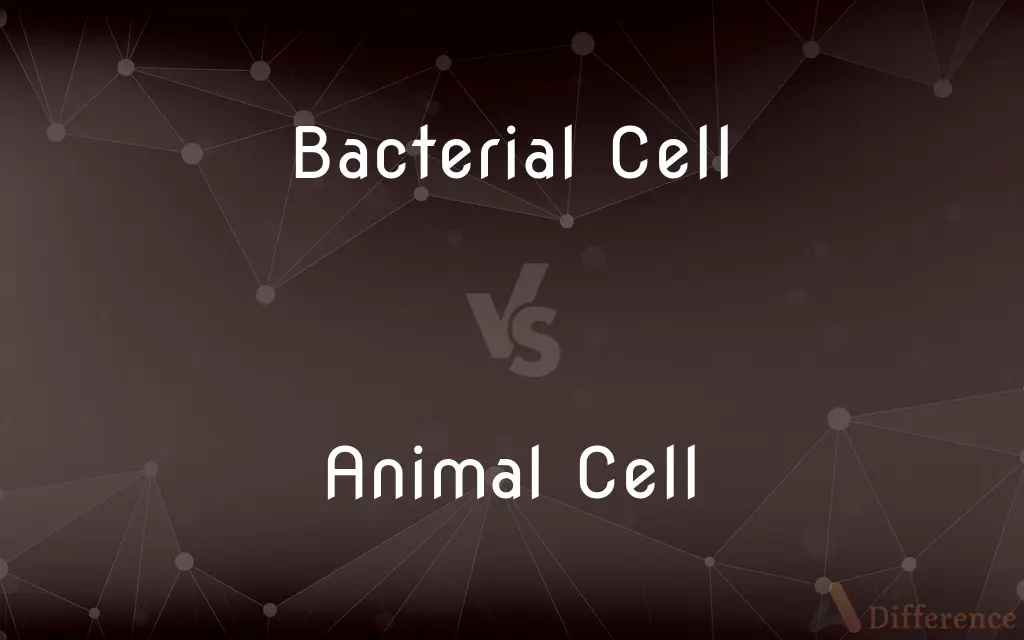Bacterial Cell vs. Animal Cell — What's the Difference?
By Tayyaba Rehman — Published on November 20, 2023
Bacterial Cell is prokaryotic without a nucleus; Animal Cell is eukaryotic with a nucleus.

Difference Between Bacterial Cell and Animal Cell
Table of Contents
ADVERTISEMENT
Key Differences
Bacterial Cells are the fundamental units of life for bacteria. They belong to the prokaryotic domain, which means they lack membrane-bound organelles, including a nucleus. Their genetic material floats freely in a region called the nucleoid.
Animal Cells, in contrast, are eukaryotic. This means they contain a nucleus that houses their DNA. They also possess various membrane-bound organelles like mitochondria, endoplasmic reticulum, and the Golgi apparatus. These organelles allow the cell to perform specialized functions, promoting the overall health and function of the organism.
Bacterial Cells have a rigid cell wall made of peptidoglycan, which provides structural support and protection. This cell wall is often the target of antibiotics, which aim to disrupt its formation and thereby kill the bacterium.
Animal Cells, on the other hand, lack a rigid cell wall. Instead, they have a flexible cell membrane made of lipids that protects the cell and controls the movement of substances in and out. This difference in structural components influences the shapes and rigidity of these cells.
While both Bacterial and Animal Cells play vital roles in the continuity of life, they have evolved with different structures and functions to suit their unique roles. Bacteria are often single-celled organisms that can survive in various environments, while animal cells contribute to the multifaceted systems of multicellular organisms.
ADVERTISEMENT
Comparison Chart
Nucleus
Absent (Has nucleoid region)
Present
Membrane-bound organelles
Absent
Present (e.g., mitochondria, ER)
Cell wall
Present (made of peptidoglycan)
Absent
Size
Generally smaller (0.5-5 µm)
Generally larger (10-30 µm)
Genetic material
Circular DNA floating freely
DNA within a membrane-bound nucleus
Compare with Definitions
Bacterial Cell
Often unicellular in nature.
A single Bacterial Cell can reproduce independently to form a colony.
Animal Cell
Contains a distinct, membrane-bound nucleus.
The nucleus of an Animal Cell houses its genetic material.
Bacterial Cell
Bacterial Cell is a prokaryotic cell type.
E. coli is a well-studied Bacterial Cell.
Animal Cell
Possesses multiple membrane-bound organelles.
Mitochondria in an Animal Cell produce energy for the cell.
Bacterial Cell
Lacks membrane-bound organelles.
The DNA of a Bacterial Cell floats freely within the cell.
Animal Cell
Animal Cell is a eukaryotic cell type.
Human skin cells are types of Animal Cells.
Bacterial Cell
Typically smaller than eukaryotic cells.
Under a microscope, a Bacterial Cell appears much tinier than an Animal Cell.
Animal Cell
Typically larger than prokaryotic cells.
Under a microscope, an Animal Cell is discernibly bigger than a Bacterial Cell.
Bacterial Cell
Contains a rigid peptidoglycan cell wall.
Antibiotics target the cell wall of the Bacterial Cell to eliminate infections.
Animal Cell
Lacks a rigid cell wall.
The absence of a cell wall gives the Animal Cell flexibility and varied shapes.
Common Curiosities
Are Bacterial Cells typically multicellular or unicellular?
Bacterial Cells are typically unicellular.
Do Animal Cells have a cell wall like plants or bacteria?
No, Animal Cells lack a cell wall.
Where is the DNA located in an Animal Cell?
In an Animal Cell, the DNA is located within a membrane-bound nucleus.
How does the size of a Bacterial Cell compare to an Animal Cell?
Bacterial Cells are generally smaller than Animal Cells.
Can Bacterial Cells be seen without a microscope?
Individual Bacterial Cells are microscopic and cannot be seen without magnification.
What is the primary structural difference between an Animal Cell and a Bacterial Cell?
Animal Cells have a flexible cell membrane, while Bacterial Cells have a rigid cell wall made of peptidoglycan.
How do antibiotics generally target bacteria?
Many antibiotics target the peptidoglycan cell wall of Bacterial Cells to disrupt its formation.
Where can Bacterial Cells be found?
Bacterial Cells are ubiquitous and can be found in various environments, from soil to the human gut.
What's the significance of the peptidoglycan wall in Bacterial Cells?
The peptidoglycan wall provides structural support and protection to Bacterial Cells.
Do Bacterial Cells have a nucleus?
No, Bacterial Cells lack a nucleus and have a nucleoid region instead.
Are all bacteria harmful to humans?
No, many bacteria are harmless or beneficial; only a subset causes diseases.
Which cell type has membrane-bound organelles: Bacterial or Animal?
Animal Cells have membrane-bound organelles, while Bacterial Cells do not.
Do Animal Cells play a role in human immunity?
Yes, certain Animal Cells, like white blood cells, are crucial for human immune responses.
How do organelles in an Animal Cell aid its function?
Organelles in an Animal Cell perform specialized tasks, like energy production or protein synthesis, enabling the cell to function efficiently.
Can Animal Cells survive independently like many Bacterial Cells?
Typically, no. Animal Cells are part of multicellular organisms and rely on a system of cells to function.
Share Your Discovery

Previous Comparison
Strike vs. Picketing
Next Comparison
Leg Break vs. Leg SpinAuthor Spotlight
Written by
Tayyaba RehmanTayyaba Rehman is a distinguished writer, currently serving as a primary contributor to askdifference.com. As a researcher in semantics and etymology, Tayyaba's passion for the complexity of languages and their distinctions has found a perfect home on the platform. Tayyaba delves into the intricacies of language, distinguishing between commonly confused words and phrases, thereby providing clarity for readers worldwide.













































